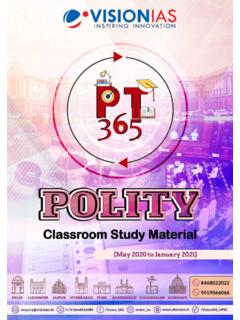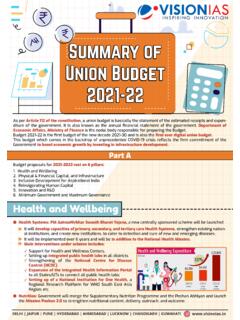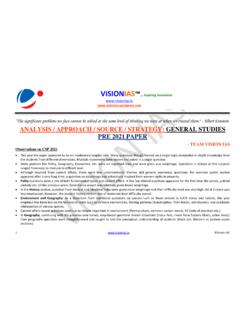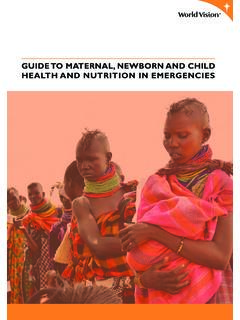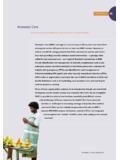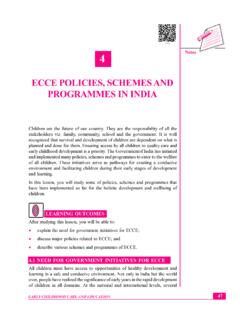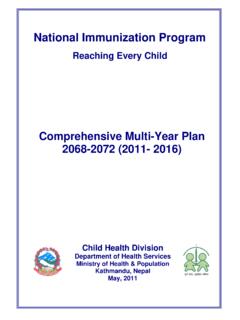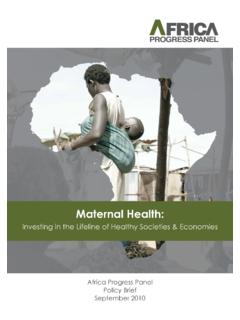Transcription of SOCIAL ISSUES
1 1 DELHI | PUNE | HYDERABAD | AHMEDABAD | JAIPUR | LUCKNOW 8468022022, 9019066066 SOCIAL ISSUES Table of Contents1. ISSUES RELATED TO WOMEN _____ 2 Beijing Declaration and Platform for Action (BPfA) _____ 2 Reproductive Rights _____ 3 Surrogacy Bill _____ 5 Women and Digital Literacy _____ 6 The Muslim Women (Protection of Rights on Marriage) Act, 2019 _____ 7 Menstrual Leave _____ 9 Gender Dimensions of the COVID-19 Pandemic _____ 10 2. ISSUES RELATED TO CHILDREN _____ 14 POCSO Act _____ 14 child Labour _____ 15 3. OTHER VULNERABLE SECTIONS _____ 18 Tribal health and Nutrition _____ 18 The Transgender Persons (Protection of Rights) Act, 2019 _____ 19 Bonded Labour _____ 21 4. DEMOGRAPHY _____ 24 Demographic changes in India _____ 24 Internal Migration _____ 26 5. health _____ 29 COVID-19 and India s Healthcare Sector 29 Role of ASHAs During Pandemic _____ 31 Anganwadi Workers _____ 33 Ayushman Bharat Pradhan Mantri Jan Arogya Yojana (PM-JAY) _____ 34 Digital health _____ 36 National Vaccination Strategy _____ 39 National Medical Commission _____ 40 Mental health _____ 42 Violence against Healthcare Workers and Clinical Establishments _____ 44 6.
2 NUTRITION AND SANITATION _____ 47 Hunger _____ 47 Food Security _____ 48 Swachh Bharat Mission (Gramin) [Phase II] _____ 49 7. EDUCATION _____ 52 New Education Policy 2020 _____ 52 School Education _____ 53 Higher Education _____ 56 Other Major Provisions _____ 57 Analysis of New Education Policy-2020 _ 58 Education as a Public Good _____ 60 E-Learning _____ 62 Annual Status of Education Report (ASER) 2019: Early childhood education _____ 65 8. MISCELLANEOUS _____ 67 Urbanisation of Pandemics _____ 67 Urban Poor _____ 68 Drug Abuse in India _____ 71 Live in Relationships _____ 73 Sustainable Development Goals (SDGs) 75 Status Report on SDGs _____ 76 Good Practices in Localising SDGs _____ 88 2 8468022022, 9019066066 DELHI | PUNE | HYDERABAD | AHMEDABAD | JAIPUR | LUCKNOW 1. ISSUES RELATED TO WOMEN Facets of women empowerment and related ISSUES : ISSUES related to Economic Empowerment: As per Global Gender Gap Report, 2020: o Women constitute only 22% of the labour force in India, compared with 82% of men.
3 O The female estimated earned income in India is mere one-fifth of the male income (among the world s lowest). o Women representation on company boards in India is also very low at mere Political Empowerment: Women in India held just of parliamentary (lower-house) seats in 2019. Educational attainment: In India, 66% of women are literate compared with 82% of men. Imbalanced sex ratio: A combination of son and small family-size preferences and the availability of prenatal sex determination technologies have resulted in imbalanced sex ratios. o Despite sex-selective abortions being illegal since 1996, the sex ratio at birth has remained persistently high at 110 male births per 100 females since 2000. Crimes against women: increased per cent from 2018 to 2019. Majority of cases under crime against women were registered under cruelty by husband or his relatives .Women in India face domestic violence due to a variety of reasons including:- o Orthodox & Patriarchal mindset: which leads to male domination and control over women, male privilege and women s subordinate status in society.
4 O Changing socio- economic relations particularly in urban areas such as higher income of a working woman than her partner, abusing and neglecting in-laws, dowry demands etc. may lead to violence. BEIJING DECLARATION AND PLATFORM FOR ACTION (BPFA) Why in news? The year 2020 marks the twenty-fifth anniversary of the Fourth World Conference on Women and adoption of the Beijing Declaration and Platform for Action (1995) (Beijing + 25). About Beijing Declaration and Platform for Action (1995) BPfA was adopted in Fourth World Conference on Women (1995). It sets strategic objectives and actions for advancement of women and achievement of gender equality in 12 critical areas of concern. 1995 Fourth World Conference on Women, held in Beijing, was one of the largest gatherings of the United Nations, and a critical turning point in the world s focus on gender equality and the empowerment of women. o United Nations has organized four world conferences (WC) on women.
5 Three others are First WC in Mexico City (1975), Second WC in Copenhagen (1980) and Third WC in Nairobi (1985). o Worldwide progress in implementation of BPfA is reviewed every five years by Commission on the Status of Women (CSW). o CSW is a functional commission of UN Economic and SOCIAL Council (ECOSOC) and principal global intergovernmental body exclusively dedicated to promotion of gender equality and women empowerment. The platform is not a legally binding document, but rather a guide for the governments and non-governmental organizations. It for the first time facilitated the persistent discrimination against and violation of the rights of the girl child , getting included as a separate critical area of concern addressing ISSUES such as child marriage, female infanticide, genital mutilation and prenatal sex selection. India s major achievements in the promotion of empowerment of women since the adoption of the Beijing Declaration and Platform for Action 12 critical areas of concern Women and the environment Women in power and decision-making The girl child Women and the economy Women and poverty Violence against women Human rights of women Education and training of women Institutional mechanisms for the advancement of women Women and health Women and the media Women and armed conflict 3 DELHI | PUNE | HYDERABAD | AHMEDABAD | JAIPUR | LUCKNOW 8468022022, 9019066066 Setting up Nodal Ministry of Women and child Development (MoWCD), to give the much-needed impetus to the holistic development of women and children.
6 O Two Statutory Commissions have been established to safeguard the constitutional and legal rights of women and Children, namely: National Commission for Women (NCW) National Commission for Protection of child Rights (NCPCR) Enactment of Enabling Legislations: such as, The Criminal Law (Amendment), Act 2013, The Sexual Harassment of Women at Workplace (Prevention, Prohibition and Redressal) Act, 2013, The Protection of Women from Domestic Violence Act (2005), The Dowry Prohibition Act, (1961) The Prohibition of child Marriage Act (2006) The Protection of Children from Sexual Offences Act, (2012), The Pre-Conception and Pre-Natal Diagnostic Techniques Act (PC&PNDT) 1994. Programme and Schematic Intervention: GoI, has been implementing number of schemes and programmes for creating an enabling environment for women and also children. Such as, o integrated child Protection Scheme (ICPS), o Indira Gandhi Matritva Sahyog Yojana (IGMSY) for pregnant and lactating women to improve their health and nutrition status, o Support to Training & Employment programme for Women (STEP) scheme to ensure sustainable employment and income generation.
7 O Ujjawala scheme is implemented for prevention of Trafficking and Commercial Sexual Exploitation Mechanisms for Convergence: Convergence is the key to effective implementation of Ministry s programmes. For example: To improve child Sex Ratio and empowering the Girl child (Beti Bachao Beti Padhao) a joint schematic initiative of Ministry of health & Family Welfare, Human Resource Development with MoWCD. Gender Budgeting Initiatives: GoI introduced a Gender Budget Statement as part of the Union Budget, as an important tool for reporting allocations for women and provides an indication of the funds flowing to them. To institutionalise this Gender Budgeting Cells (GBCs) in all Ministries / Departments was set up. National Policy for the Empowerment of Women 2001: Aimed at bringing about advancement, development and empowerment of women in all spheres of life through creation of a more responsive judicial and legal system sensitive to women and mainstreaming a gender perspective in the development process.
8 High Level Committee on Status of Women (HLC) in 2012, was constituted to understand the status of women since 1989 and to evolve appropriate policy intervention based on a contemporary assessment of women s needs. REPRODUCTIVE RIGHTS Why in News? Recently, Cabinet has approved Medical Termination of Pregnancy (Amendment) Bill, 2020 for amending Medical Termination of Pregnancy Act, 1971. What are reproductive rights? These are the rights of individuals to decide whether to reproduce and have reproductive health . This may include an individual's right to plan a family, terminate a pregnancy, use contraceptives, gain access to reproductive health services, learn about sex education in public schools, and gain access to reproductive health services. Significance of Reproductive right for women o As a Human right: Being able to make decisions about own bodies and lives is a basic human rights. o Importance for maternal healthcare: Access to contraception, birth control and safe and hygienic abortion services and timely and well spaced pregnancies are crucial to reduce maternal mortality rate and ensure maternal and newborn health .
9 maternal Mortality Rate (proportion of maternal deaths per 1,00,000 live births reported) of India was 122 in 2015-17. o Women s SOCIAL and economic advancement: Women s ability to obtain and effectively use contraceptives has a positive impact on their education and workforce participation, as well as on subsequent outcomes related to income, family stability, mental health and happiness, and children s well-being. 4 8468022022, 9019066066 DELHI | PUNE | HYDERABAD | AHMEDABAD | JAIPUR | LUCKNOW ISSUES related to Reproductive rights in India ISSUES Medical Termination of Pregnancy (MTP) Act, 1971 o Denial of Reproductive rights to Unmarried women: It does not contain provisions for unmarried women seeking abortion in case of contraceptive failure. o Upper limit of 20 weeks: Under the act, termination of pregnancy beyond 20 weeks needs approval of the court. This is problematic since a number of foetal abnormalities are detected after 20 weeks and resent medical techniques allow for safe removal of a foetus at a relatively advanced state of pregnancy.
10 Also there have been some cases where the 20-week mark passed due to delay in courts or low awareness among young girls, leaving many, including rape survivors, with unwanted pregnancies. Challenges in public health system: It faces a range of ISSUES , including low public investment, poor infrastructure, including medical and diagnostic facilities, and inadequately skilled human resources etc. Societal pressures: There exists a SOCIAL stigma related to abortion and contraception and sex education are taboo topics in India. Unmarried women have limited to access birth control due to such pressures. Patriarchal structure: It affects women s agency to make free reproductive choices and also leads to women undergoing unsafe abortions and sterilizations to avoid unwanted pregnancies. In this regards the Cabinet has recently approved Medical Termination of Pregnancy (Amendment) Bill, 2020 for amending Medical Termination of Pregnancy Act, 1971.
